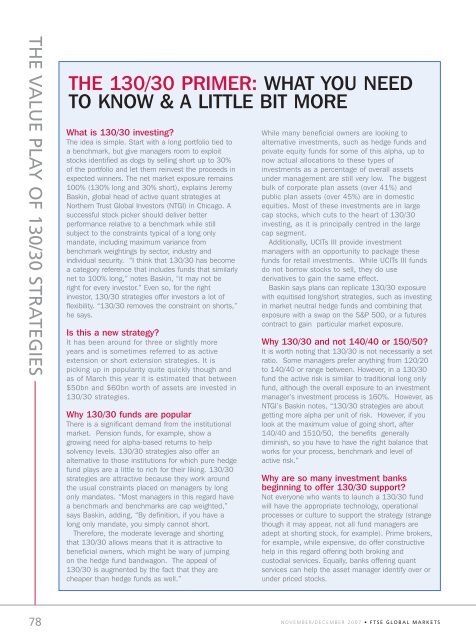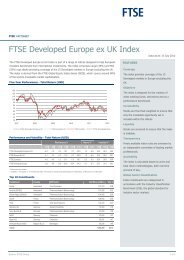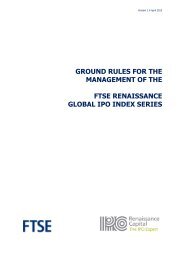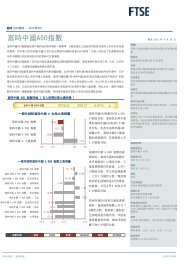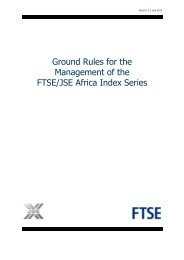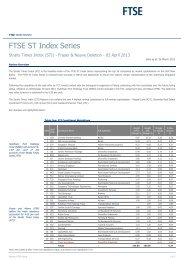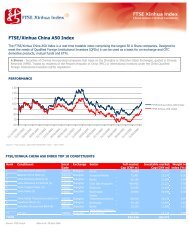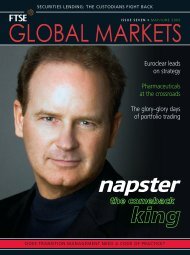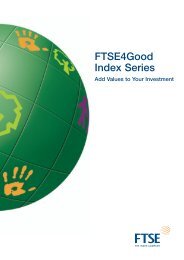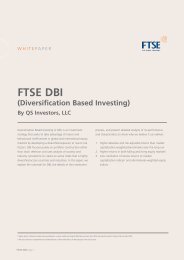Section 2 - FTSE
Section 2 - FTSE
Section 2 - FTSE
You also want an ePaper? Increase the reach of your titles
YUMPU automatically turns print PDFs into web optimized ePapers that Google loves.
THE VALUE PLAY OF 130/30 STRATEGIES<br />
78<br />
THE 130/30 PRIMER: WHAT YOU NEED<br />
TO KNOW & A LITTLE BIT MORE<br />
What is 130/30 investing?<br />
The idea is simple. Start with a long portfolio tied to<br />
a benchmark, but give managers room to exploit<br />
stocks identified as dogs by selling short up to 30%<br />
of the portfolio and let them reinvest the proceeds in<br />
expected winners. The net market exposure remains<br />
100% (130% long and 30% short), explains Jeremy<br />
Baskin, global head of active quant strategies at<br />
Northern Trust Global Investors (NTGI) in Chicago. A<br />
successful stock picker should deliver better<br />
performance relative to a benchmark while still<br />
subject to the constraints typical of a long only<br />
mandate, including maximum variance from<br />
benchmark weightings by sector, industry and<br />
individual security. “I think that 130/30 has become<br />
a category reference that includes funds that similarly<br />
net to 100% long,” notes Baskin, “it may not be<br />
right for every investor.” Even so, for the right<br />
investor, 130/30 strategies offer investors a lot of<br />
flexibility. “130/30 removes the constraint on shorts,”<br />
he says.<br />
Is this a new strategy?<br />
It has been around for three or slightly more<br />
years and is sometimes referred to as active<br />
extension or short extension strategies. It is<br />
picking up in popularity quite quickly though and<br />
as of March this year it is estimated that between<br />
$50bn and $60bn worth of assets are invested in<br />
130/30 strategies.<br />
Why 130/30 funds are popular<br />
There is a significant demand from the institutional<br />
market. Pension funds, for example, show a<br />
growing need for alpha-based returns to help<br />
solvency levels. 130/30 strategies also offer an<br />
alternative to those institutions for which pure hedge<br />
fund plays are a little to rich for their liking. 130/30<br />
strategies are attractive because they work around<br />
the usual constraints placed on managers by long<br />
only mandates. “Most managers in this regard have<br />
a benchmark and benchmarks are cap weighted,”<br />
says Baskin, adding, “By definition, if you have a<br />
long only mandate, you simply cannot short.<br />
Therefore, the moderate leverage and shorting<br />
that 130/30 allows means that it is attractive to<br />
beneficial owners, which might be wary of jumping<br />
on the hedge fund bandwagon. The appeal of<br />
130/30 is augmented by the fact that they are<br />
cheaper than hedge funds as well.”<br />
While many beneficial owners are looking to<br />
alternative investments, such as hedge funds and<br />
private equity funds for some of this alpha, up to<br />
now actual allocations to these types of<br />
investments as a percentage of overall assets<br />
under management are still very low. The biggest<br />
bulk of corporate plan assets (over 41%) and<br />
public plan assets (over 45%) are in domestic<br />
equities. Most of these investments are in large<br />
cap stocks, which cuts to the heart of 130/30<br />
investing, as it is principally centred in the large<br />
cap segment.<br />
Additionally, UCITs III provide investment<br />
managers with an opportunity to package these<br />
funds for retail investments. While UCITs III funds<br />
do not borrow stocks to sell, they do use<br />
derivatives to gain the same effect.<br />
Baskin says plans can replicate 130/30 exposure<br />
with equitised long/short strategies, such as investing<br />
in market neutral hedge funds and combining that<br />
exposure with a swap on the S&P 500, or a futures<br />
contract to gain particular market exposure.<br />
Why 130/30 and not 140/40 or 150/50?<br />
It is worth noting that 130/30 is not necessarily a set<br />
ratio. Some managers prefer anything from 120/20<br />
to 140/40 or range between. However, in a 130/30<br />
fund the active risk is similar to traditional long only<br />
fund, although the overall exposure to an investment<br />
manager’s investment process is 160%. However, as<br />
NTGI’s Baskin notes, “130/30 strategies are about<br />
getting more alpha per unit of risk. However, if you<br />
look at the maximum value of going short, after<br />
140/40 and 1510/50, the benefits generally<br />
diminish, so you have to have the right balance that<br />
works for your process, benchmark and level of<br />
active risk.”<br />
Why are so many investment banks<br />
beginning to offer 130/30 support?<br />
Not everyone who wants to launch a 130/30 fund<br />
will have the appropriate technology, operational<br />
processes or culture to support the strategy (strange<br />
though it may appear, not all fund managers are<br />
adept at shorting stock, for example). Prime brokers,<br />
for example, while expensive, do offer constructive<br />
help in this regard offering both broking and<br />
custodial services. Equally, banks offering quant<br />
services can help the asset manager identify over or<br />
under priced stocks.<br />
NOVEMBER/DECEMBER 2007 • <strong>FTSE</strong> GLOBAL MARKETS


